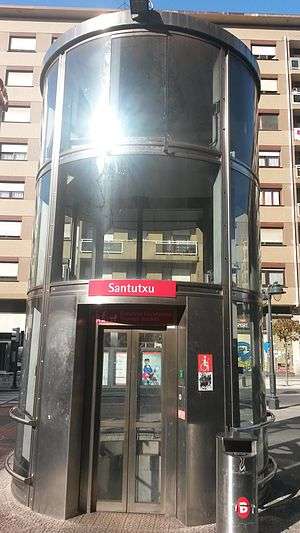Santutxu
Coordinates: 43°15′15″N 2°54′42″W / 43.25417°N 2.91167°W

| Santutxu | |
|---|---|
| Santutxu | |
| Country |
|
| Autonomous community | Basque Country |
| Province | Biscay |
| City | Bilbao |
| District |
|
| Population | 33.346 inhabitants |
| Demonym(s) | Santutxutarra |
| Time zone | CET (UTC+1) |
| • Summer (DST) | CEST (UTC+2) |
| Postal code | 48001 – 48015 |
| Dialing code | +34 94 |
| Official language(s) |
Basque Spanish |
Santutxu (spelled as Santuchu when written in Spanish) is one of the most populous neighbourhoods of Bilbao (Basque Country). It belongs to the 4th urban district, named Begoña. It is a popular residential neighbourhood which has also a relatively strong commercial area, including three food retail markets. The neighbourhood is under an incredible population density and this causes negative consecuences. For example, there are not enough parks and gadens and this is one of the main complains of the neighbours. Another problem is the lack of parkings for the cars. This problem is very common between the neighbours. It belongs to the 4th urban district, named Begoña, which is completed by three neighbourhoods, Santutxu, Begoña and Bolueta. Begoña and Bolueta are much less populated than Santutxu, Bolueta has 4454 inhabitants and Begoña has 5326. While Santutxu has 33516 inhabitants.[1] Moreover, it is one of the most densely populated neighbourhood of Bilbao and of Europe, at 41.378 hab/km2 as of 2008.[2]
History
Santutxu (meaning little Saint in Basque), owes its name to a hermitage which was dedicated to Francisco de Paula. This hermitage was founded in 1737 by Francisco Fernando de Barrenechea among others, and was built with the sole purpose of enabling its colonists to hear masses without moving to Begoña church. Since both the hermitage and the Saint figure inside were small sized, it was popularly given the name Santutxu, Santuchu in Spanish. Moreover, the word Santutxu is the result of the union of two basque words, santu which means holy in basque and txu which is a diminutive suffix, also in basque.
In those first years, every second of April was celebrated in honor of San Francisco de Paula with a Major Mass of great solemnity. Representatives of the Hall of the República de Begoña would attend this event, as well as members of the clergy that would take part in every religious event back in those days, where rockets, drumming and of course, a typical homemade Basque wine named txakoli or chacolí in Spanish, were the order of the day.
In 1925, the church of Begoña was annexed (and with it, the neighbourhood of Santutxu) to Bilbao. In the XX century it went from being a semi-rural zone with great sandlots, to a highly populated neighbourhood, especially after the building and demographic growth of the 1960s.
Luis Briñas Public school is a detached building in Santutxu, located on Iturriaga street, near the Campa de Basarrate. It is monumentally protected and was designed by the architect Pedro Ispizua Susunaga (Bermeo, 1895 - Bilbao, 1976), who also designed the del Tigre, the Mercado de la Ribera, the pergola of Parque Casilda Iturrizar or the Kiosco del Arenal.
In Santutxu, according to the Bilbao Hall census data of 2008, there are 33,346 inhabitants.
Famous people from Santutxu
- Javier Calle, journalist and TV host.
- Javier Salgado, player of Movistar CB Estudiantes and ex-player of Bilbao Basket and Lagun Aro Bruesa Gipuzkoa Basket
- Ibai Gómez, footballer, player of Athletic Club de Bilbao.
- Aitor Mazo, actor.
Events in Santutxu
- "Santutxu pintxotan" is a gastronomic event and contest for catering professionals from Santutxu which takes place once a year in some bars of the neighbourhood.[3]
- "Premios Santutxu y más" is an event created by the journal of the neighbourhood to give awards to those relevant people, organisations or entities that have appeared in its pages during the last year.
Organisations related with Santutxu
- Santutxu families' association, which was created in 1967.
- Santutxu FC: Santutxu football team.
- Storekeepers' association [4]
- Begoña's teenager area: Free time area for teenagers (from 13 to 17 years) from Santutxu, Begoña and Bolueta neighbourhoods
- Social center for the Santutxu elderly [5]
- "Bizit Santutxu": Associative project of crowdfunding, which seeks sponsorships for the neighbourhood's sports clubs, but also to foment the consumption in local shops.
Transports

Bilbobus
| Line | Itinerary | Frequency (minutes) |
|---|---|---|
| 13 | San Ignacio - Txurdinaga | 15' |
| 34 | Otxarkoaga - Santutxu | 30´ |
| 40 | La Peña - Plaza Biribila | 20´ |
| 43 | Garaizar - Santutxu | 30´ |
| 48 | Santutxu - Lezeaga | 20´ |
| 77 | El Peñascal - Mina del Morro | 12´ |
Bilbao Underground
There are two underground stations (Metro Bilbao):
- Santutxu station, which has two way out, one in Karmelo street and another one in Zabalbide street.
- Basarrate station which has the way out in Basarrate square.
References
- ↑ Vázquez, Solange (October 11, 2009). "43.000 habitantes en poco más de un kilómetro cuadrado". elcorreo.com. elcorreo. Retrieved May 10, 2005.
- ↑ Isabel Sánchez Robles (28 February 2008). BILBAO Zenbatekoetan 2008 (PDF) (Report). Bilboko Udala. Hiritarrekiko Harremanen Saila. p. 17. Retrieved 15 April 2016.
- ↑ PINTXOTAN, SANTUTXU (2015). "SANTUTXU PINTXOTAN". Santutxu pintxotan. Retrieved 22 May 2016.
- ↑ "AGRUPACIÓN DE COMERCIANTES SANTUTXU MERKATARIEN ELKARTEA". Agrupación de comerciantes Santutxu. Retrieved 22 May 2016.
- ↑ UDAL EKIPAMENDUAK (PDF) (Report). Bilboko Udala. Hiritarrekiko Harremanen Saila. p. 9. Retrieved 22 April 2016.
